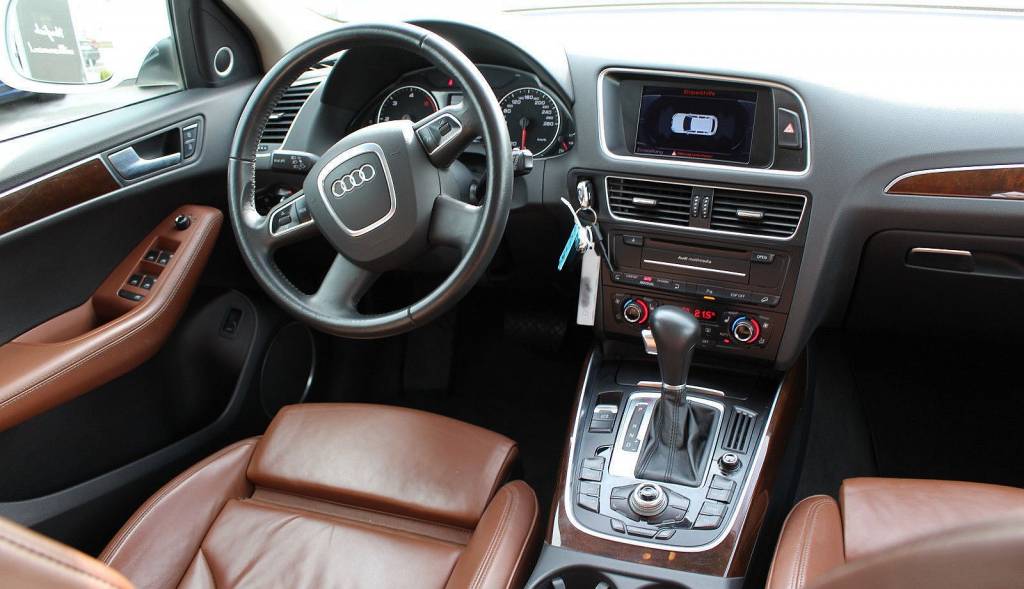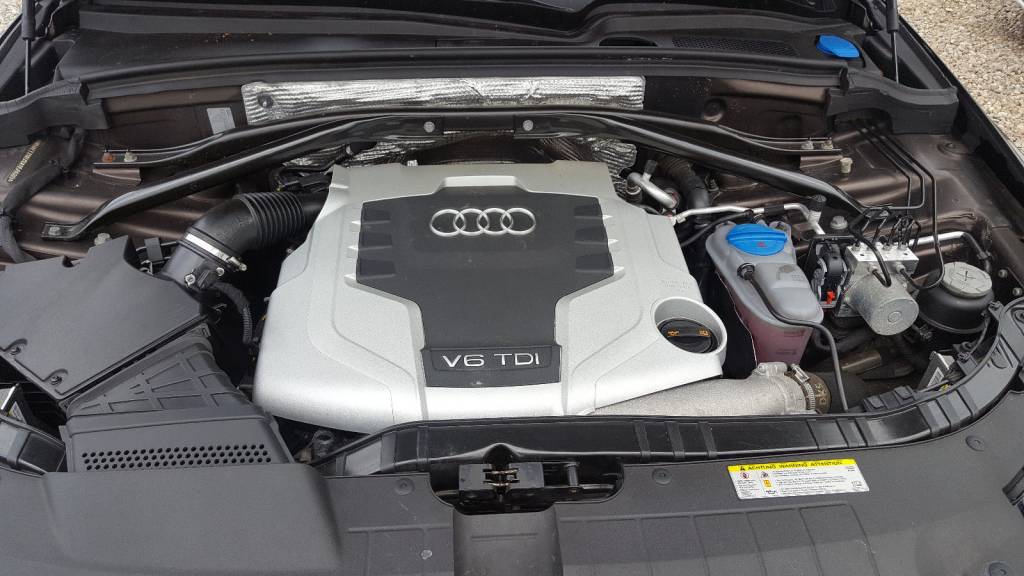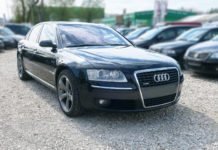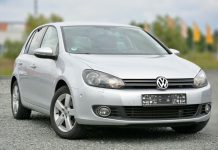If you desperately need an Audi SUV but the Q7 seems too big or too complex, then the Q5 can be your choice.
The price for this first generation Audi Q5 currently starts at 8 500 € for the cheapest one in Germany. Of course I would just put a huge question mark on the reliability of this cheapest piece, but it’s still at least a German made SUV. Since the newest Q5 is made in Mexico – to save production costs obviously. This can be a problem for the average German Audi employee, but it’s not really a problem for the average consumer. Although you know, those well-known rumors about the cars made in Mexico are still alive and well.
But back to the older Q5.

The interior layout is very similar to the Audi A4 B8, so the quality of the used materials is great and the interior is basically not worn in high mileage cars too. Except maybe the start-stop button which can be occasionally worn out.
(56 € price for the updated genuine start stop button, part number: 8K0905217C )
The big storage pockets in the doors improve the overall practicality, as well as the increased headroom compared to the already mentioned A4 for example. Lastly, the build quality of the interior is good, although some of the owners complained about rattling or squeaking noise from the rear seat area. If the car is equipped with a panoramic sunroof then that can also make some rattling/squeaking noise mainly on bad roads.
Body, paintjob, rust protection
It seems like that the quality of the paintjob and the corrosion protection is better than in the already mentioned A4 which can have rusty fenders or tailgate, so there should be no rust on the body panels. Although it’s still good to check the car properly for rust.

Possible problems
The reliability of this SUV is on a very good level (except the engines or gearbox) but nothing is perfect so even this car can have some minor issues not related to engine or gearbox:
-There can be problem with the: electrically operated trunk, MMi multimedia system or occasionally the LED daytime running lights won’t work.
This Q5 had some recalls, so make sure that the car has a proper maintenance history and all the recalls were already fixed. For example there was a recall for the panoramic sunroof glass which can suddenly break to pieces – but only in very cold weather. This can happen when the car is parked outside and the temperature is below -20°C.
Lets just stop for a moment because this awesome panoramic sunroof has another issue which is related to the drain hoses which can cause water leak into the interior.

There are 4 drain tubes in each corner of the panoramic sunroof, These drain tubes can be clogged, but also the upper plastic endings of the drain tubes can get a little loose over time creating a gap around the connection which allows the water to leak not just into, but also onto the drain hose and into the interior. By the way the first generation Q7 or the A4 (B8) are also affected by this design flaw. To access these drains you have to remove certain parts of the headliner which is really a fun job to do. So if you don’t want to experience this, then avoid cars with this awesome piece of engineering.
Suspension
There are 3 types of suspension:
-The first is the standard suspension, which is good enough.
-Then there is the factory sport suspension, which was the part of the optional S-line sport package. This suspension is great, but mainly on good quality roads.
-The last suspension type is also the optional electronically adjustable adaptive suspension, which is the best solution when it comes to handling and comfort, since you can adjust it from comfort to dynamic mode.
There are no extraordinary / premature issues with the suspension components, just listen to all those knocking or clunking noises and be prepared that the electronic shocks are obviously more expensive than the regular type.
The standard equipment contains only the standard stuff, so there is nothing special. However, the optional equipment list is quite big.
This Q5 can be equipped with: still not outdated navigation system, leather seats, electrically adjustable and heated front seats, heated rear seats, multifunctional steering wheel with paddle shifters, keyless entry, limitless interior color and trim combinations, parking camera, adaptive cruise control, great Bang and Olufsen sound system and lets not forget the infamous panoramic sunroof.
The facelifted version of this Audi was made from 2012. This facelift included some minor exterior and interior upgrades, also some new interior trim combinations were added.

Petrol engines
The petrol engines can have some problems. So, let’s start with the 2.0 l TFSI 4 cylinder.
So these 2.0 l TFSI engines made to 2011 can have more often problems with the prematurely worn timing chain mechanism or oil consumption.
Timing chain / tensioner issues
-In these early engines the timing chain can be easily worn out at around 150 000 km but also before this mileage point, or even before 100 000 km. In this case you will mostly get a short louder rattle at cold start from the engine and if you let it be, then the chain tensioner fails allowing the chain to skip causing: check engine light, fault codes, misfires/rough idle and you will eventually end up with a damaged or a destroyed engine. So it is a good idea to preventively replace the timing chain mechanism after 100 000 km in cars made to 2012, although there should be an extended warranty in the US for the timing chain mechanism of these cars made to 2012 for 10 years or 100 000 mi, so the dealer should completely or partly cover the repair costs if the chain fails.
The timing chain tensioner was redesigned several times, but only cars made from 2013 are equipped with the finally sorted tensioner. And that’s why the very best is to choose a 4 cylinder petrol engine made from 2013. Of course some late 2012 models can have the updated tensioner, but nobody knows if the car really has it unless you check it personally.
Keep in mind that if you are replacing the timing chain mechanism then it’s also important to preventively replace the cam-bridge or camshaft bridge or camshaft bracket in other words. A tiny screen in it can become loose or fall out and either end up somewhere in the oil path, or get stuck between a metallic ball which acts like a valve to control the oil pressure to the camshafts. This can cause oil starvation issues in the cylinder head and lead to premature camshaft wear + other issues which are definitely not good. But actually some say that the metallic ball can even completely fall out as well and cause other serious damage in the engine. Luckily only cars made to 2009 are mostly affected by this, since they have the earliest weak cam bridge. But because the cam-bridge was revised more than 3 times I would replace it also in younger cars with the timing chain.
Oil consumption
-Then there is the infamous issue with the excessive oil consumption which affects again these 4 cylinder engines made to 2011. The oil consumption is caused by undersized pistons, undersized piston rings and badly designed oil scraper rings – this is basically the area under the piston rings + thanks to the long oil change intervals the badly designed area under the piston rings gets clogged up with carbon. Because all of these reasons the oil will easily enter the combustion chamber and burn with the fuel. If you won’t solve this in time then the oil consumption will get only worse and you will end up with a clogged catalytic converter and destroyed engine in the worst case. To fix this oil consumption in these early engines you have to replace the pistons (-if there is no other damage of course). Although the pistons were replaced a lot of times under warranty + there should be an extended warranty for 8 years / 80 000 mi in the US for this particular issue.
“price for replacing the pistons at the dealer 4 000 – 6 000 €, at an independent mechanic it’s around 2 000 €”
The oil consumption can be at around 1 L / 1 000 or 1 500 km, but it can be much worse as well, like 2 L / 1 000 km.
This is why you should avoid these 4 cylinder petrol engines like the plague in cars made to 2011, unless the pistons and piston rings were replaced not a long time ago and the previous owner changed the oil after max. 10 000 km after fixing the engine.
Cars made from 2012 are basically not affected by the oil consumption, although in rare cases they can also consume smaller or bigger amount of oil.
“By the way, the oil consumption can be caused by the faulty pcv valve too-there are numerous revisions of this part as well. Faulty turbochargers can also cause oil consumption but mainly on abused cars. Keep in mind that these engines should not consume oil even after 10 000 km-if they are in good condition of course.”
-Problems with the leaking water pumps are also not uncommon, again in the 4 cylinder petrol engines. The water pump was updated at least twice so be prepared that it can start to leak prematurely mainly on cars made before 2012.
“new genuine water pump for 4 cylinder petrol engines – from 288 €”
All of the petrol engines are equipped with direct injection, so the well-known carbon build up can be a problem after approximately 160 000 km. Ignition coils or occasionally the injectors are also things which can fail more often.
“Carbon build up symptoms – misfires/rough idle, decrease in power/fuel economy”
Long story short,the last generation 2.0 l TFSI with 225 hp made from 2013 is pretty reliable.
All the V6 petrol engines are pretty reliable as well, so they don’t really have any extraordinary issues, although there are some cases of higher oil consumption in cars equipped with the 3.0 TFSI engines.
I would personally not recommend the hybrid version, which is capable of doing only 3km in full electric mode. So, yes you can save some fuel with the hybrid version, but it’s not an extremely big difference compared to the standard version. But if you really want it, then at least make sure that the hybrid battery is in a good condition, so bring it to the dealer-they should be able to check the battery condition.

Diesel engines
The diesel engines don’t have much issues, just keep in mind that:
-The infamous Bosch CP4 high pressure fuel pump can fail mainly in the 2.0 TDI 4 cylinder engines made to 2012, and mostly because of the different fuel used in Eastern Europe or in the US. If it fails it will throw small metal particles in the fuel system, thus destroying the injectors and sometimes these particles will contaminate the fuel tank as well. So in this case the whole or just certain parts of the fuel system including the injectors and the high pressure fuel pump has to be replaced. More information about this issue in the used BMW X5 F15 article.
-If you are buying the 2.0 TDI made to 2009 which has around 200 000 km then it’s good to drop the oil pan and check out the oil pump drive for wear since these early engines can be still equipped with not the latest revision of this part.
-The 3.0l TDI V6 is a good engine, but it has these intake manifold flaps which can sometimes fail. In this case you get only a check engine light. The flaps can be stuck, loose or the actuator motor can be faulty. The whole intake manifold part is obviously expensive-around 500 €, but you can find repair kits for a much reasonable price.
The injectors can be faulty on all of the diesel engines, but usually just after 200 000 km. In this case you can most of the time notice a couple of signs like the occasional light grey smoke from the exhaust while acceleration or at idle, and also a slightly bouncing idle when the engine is warmed up.
Genuine injectors for these diesel engines – from 630 €

It’s very important to change the oil in the engine after 15 000km, but the best is to change it after 10 000 km.
All the engines are equipped with timing chains except the 2.0 l diesel engine.
You should be prepared to replace the chain mechanism after 200 000 km since after this mileage point the tensioner and the chain itself can be worn out in all of the petrol engines. The 4 cylinder petrol engines made to 2012 can have worn chain earlier but I already mentioned that.
The 2.0 l diesel engine has a timing belt. The original interval to change should be at 180 000 km (but check it in the owners manual), but it’s a better idea to replace it at around 150 000 km with all the pulleys and the water pump.
Transmissions
This Q5 can be equipped with the 6 speed manual gearbox or there are 2 types of automatic transmissions.
-The 6 speed manual is reliable, however check the clutch properly before buying – It should operate smoothly without any kind of strange noises, vibrations or shuddering since there are numerous cases of worn Dual mass flywheel even at around 100 000 or 150 000 km which can, except the already mentioned symptoms, also cause vibration at idle or metallic clattering sounds from the gearbox area. To extend the lifetime of the dual mass flywheel you should always release the clutch calmly rather than releasing it suddenly and never let the engine to operate at low RPM – so make sure that while driving the RPM stays above 1 400 RPM.
-Then there is the S–tronic dual clutch gearbox which is not that reliable, although it shifts really fast so it’s great for dynamic driving. If you experience shuddering, hesitation or not smooth shifting then most probably the mechatronics unit will be faulty since this issue is the most common in these transmissions.
If you are buying a car with the dual clutch S–tronic gearbox then pay attention if the car has a tow hook or not, since the lifetime of the clutches in this particular gearbox can be much shorter if the car was used for towing. On abused cars the issues can occur sometimes even before 100 000 km. To extend the lifetime of this gearbox you should change the oil in it regularly after 40 000 km and avoid hard accelerations from stand still – this way it should withstand 200 000 km without issues.
-The last automatic gearbox is the older 6 speed or the newer 8 speed Tiptronic automatic – which was available after facelift. Both of them are usually reliable enough.
All of the automatic transmissions have to change gears without shuddering, strange sounds, fluctuating RPM.
As usual, I recommend to change the oil in the aut. gearbox every 60 000 kilometers.
Before buying check the suspension parts and all the electronics. The car should ride quietly, so it shouldn’t make rattling, squeaking or humming noises from the suspension.
Also check the gaps between the body panels – they should be even on the left and on the right side too.
I hope that these information are helpful enough, if you have personal experience with this car then you can write it into comments!














Is it possible to specify motors with tiptronic gearbox?